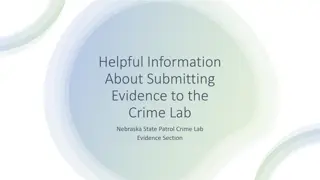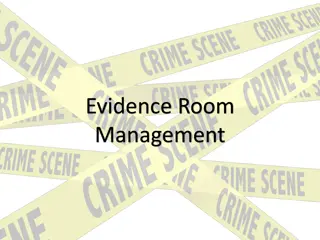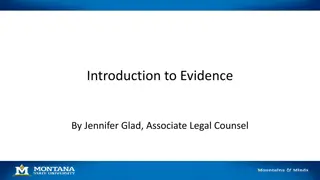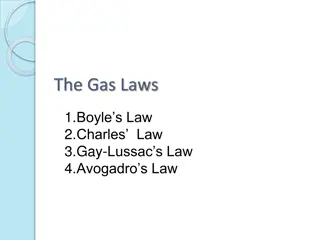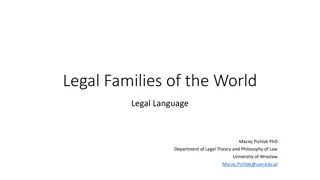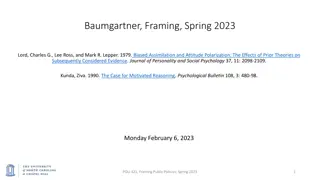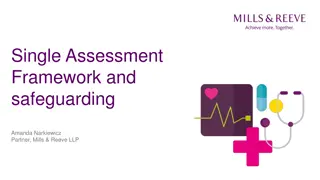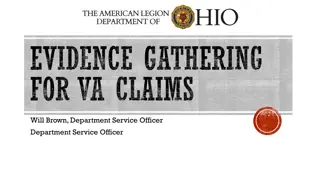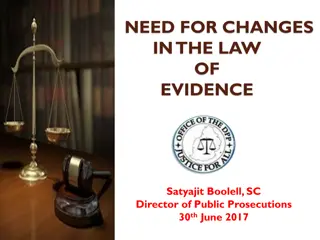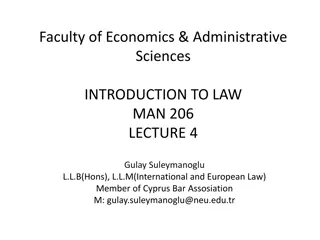Qanun-e-Shahadat: Law of Evidence in Pakistan
Qanun-e-Shahadat Order 1984 replaced the Evidence Act of 1872 in Pakistan, aiming to align the law of evidence with Islamic principles. This law is crucial for judicial proceedings, governing the admissibility of oral and documentary evidence, primary and secondary evidence, and resolving conflicts between different types of evidence. The Order applies to all courts in Pakistan, emphasizing the importance of evidence in civil and criminal cases.
Uploaded on Dec 06, 2024 | 0 Views
Download Presentation

Please find below an Image/Link to download the presentation.
The content on the website is provided AS IS for your information and personal use only. It may not be sold, licensed, or shared on other websites without obtaining consent from the author.If you encounter any issues during the download, it is possible that the publisher has removed the file from their server.
You are allowed to download the files provided on this website for personal or commercial use, subject to the condition that they are used lawfully. All files are the property of their respective owners.
The content on the website is provided AS IS for your information and personal use only. It may not be sold, licensed, or shared on other websites without obtaining consent from the author.
E N D
Presentation Transcript
QANOON E SHAHADAT (LAW OF EVIDENCE) Presented by Qanun-e- Shahadat Justice Retired Nadeem Azhar Siddiqi Advocate Supreme Court of Pakistan 1
Contents Page No. QANUN-E-SHAHADAT ORDER 1984 3 JUDICIAL PROCEEDINGS 8 QUASI JUDICIAL 9 APPLICATION OF ORDER 10 WHO MAY TESTIFY 11 ORAL EVIDENCE 14 DOCUMENTARY EVIDENCE 16 Qanun-e- Shahadat PRIMARY EVIDENCE 18 SECONDARY EVIDENCE 19 CONFLICT BETWEEN ORAL AND DOCUMENTARY EVIDENCE 20 DIRECT AND CIRCUMSTANTIAL EVIDENCE 21 2
QANUN-E-SHAHADAT ORDER 1984 The Qanun-e-Shahadat Order replaced the Evidence Act (I of 1872). (The Qanun-e-Shahadat hereinafter referred to as Order) The purpose of enactment of the Order is said to consolidate the law of evidence so as to bring it in confirmatory with the injunctions of Islam as laid down in the Holy Quran and Sunnah. Qanun-e- Shahadat It was enacted in the days when General Muhammad Zia-ul- Haq was the President of Pakistan and there was a move to make the laws in confirmatory with injunctions of Islam. 3
.Contd QANUN-E-SHAHADAT ORDER 1984 The decision of every case civil or criminal depends upon evidence and application of the principles of the law of evidence is necessary. It has to be applied in almost in every matter that s come before the Court and its usefulness in civil and criminal cases is the same. The Order is applicable in the whole of Pakistan and applies to all judicial proceedings, or before any Court, including a Court Martial, a Tribunal or other authority exercising judicial or quasi judicial powers or jurisdiction, but does not apply to proceedings before an Arbitrator. Qanun-e- Shahadat 4
.Contd QANUN-E-SHAHADAT ORDER 1984 The Qanun-e-Shahadat prescribes procedure and methods with regard to recording of evidence of parties for the purpose of proving facts and documents. If we carefully examine the provision of Evidence Act, 1872 and Qanun-e-Shahadat Order we found that except with few exceptions the Qanun-e-Shahadat Order is subjectively the same as of Evidence Act with exception of Article 3, Article 4 to 6, addition of Article 44 and addition of a proviso to Article 42. Articles 163 to 166 were also added in the new law. It is said that almost all the provisions of the Evidence Act, 1872 with a few amendments have been kept intact because most of the provisions of Evidence Act, 1872 were not repugnant to Islamic principles of law. Qanun-e- Shahadat 5
.Contd QANUN-E-SHAHADAT ORDER 1984 Article 163 deals with acceptance or denial of claim on oath. When the Plaintiff takes oath in support of his claim the court shall, on the application of the Plaintiff call upon defendant to deny the claim on oath. Article 164 deals with the evidence that has become available because of modern device etc. In such cases as the court may consider appropriate, the court may allow to be produced any evidence that may be become available because of modern devices or techniques. The telegraphic messages can be produced in evidence. Qanun-e- Shahadat 6
.Contd QANUN-E-SHAHADAT ORDER 1984 Video recording, audio cassette, video film can also be produced in evidence. The production of these materials is subject to prove that the same is genuine and not tempered one. By insertion of Article 165 the new law was given overriding effect and by insertion of Article 166 the earlier Evidence Act, 1872 (I of 1972) was repealed. Qanun-e- Shahadat The Order has 13 Chapters and 166 Articles. It has been noticed that sections 82, 93, 113, 119, 120 and 166 of the old act have not been incorporated in the new order. All other sections of the act were available in the new law. 7
JUDICIAL PROCEEDINGS Judicial proceedings means discharge of duties exercisable by a Judge in a judicial proceedings in Court. For a judicial proceeding it is necessary to bear a judicial mind to determine what is fair and just in respect of the matter under consideration. It includes any proceedings in the course of which evidence is or may be legally taken on oath. A proceeding in order to judicial must relate in some way to the administration of justice or to the ascertainment of any right or liability. It was held by the Lahore High Court in the reported case of Mrs. Rani v. Commissioner of Wealth Tax Lahore 1993 PTD 206 that proceedings before income authorities were judicial in nature and authorities were exercising quasi judicial if not judicial powers. Qanun-e- Shahadat 8
QUASI JUDICIAL The concept of quasi judicial implies that the act is not wholly judicial. It describes only a duty cost on the executive body or authority to conform to forms of judicial procedure in performing some acts in exercise of its executive power. The quasi may indicate that the tribunal is not acting purely administratively or that it is acting in a manner in which the judicial tribunal is expecting to act. Qanun-e- Shahadat 9
APPLICATION OF ORDER This order applies to all judicial proceedings in or before any court which includes all persons legally authorized to take evidence but will not apply to the proceedings before the arbitrator. The reason assigned in a judgment was that arbitrators are not expected to work as slaves of technicalities when they are giving award or judging validity and legality of award by putting the same in the clutches of the Civil Procedure Code or the Qanun-e-Shahadat Order. Arbitrators are free to decide relevancy of question and decided the matter on other material. The provisions of the order are also not applicable to departmental inquiries. Qanun-e- Shahadat 10
WHO MAY TESTIFY This is a very important question. Article 3 provides that who may testify. All persons shall be competent to testify unless the court considers that they are prevented from giving evidence. Those persons who were convicted by a court for perjury or giving false evidence cannot testify. Article 17 deals with competence and number of witnesses. The competence of a person to testify and the number of witnesses required in any case shall be determined in accordance with the injunctions of Islam as laid down in The Holy Qur an and Sunnah. Article 17 (a) provides that in matters pertaining to financial or future obligations if reduced to writing the instrument shall be attested by two men, or one man and two women. Qanun-e- Shahadat 11
.Contd WHO MAY TESTIFY In all other matters, the court may accept or act on the testimony of one man and one woman. The court has to determine the competence of a witness in accordance with the qualifications prescribed by the injunction of Islam as laid down in The Holy Qur an and Sunnah. The word used is Tazkiyah, which means mode of inquiry adopted by a court to satisfy itself as to the credibility of a witness or clearing a witness from acquisition or suspicion caused upon him by the opposition party by holding an inquiry by a Qazi openly or secretly. Qanun-e- Shahadat 12
.Contd WHO MAY TESTIFY This provision is not mandatory but directory in nature and non- compliance of Article 3 is an irregularity which can be cured. In Hadd matters Tazkiyah-Al-Shuhood is a condition precedent to impose the sentence of Hadd. There should be one Muzakki (a person who testifies about the trustfulness of the witness). It is responsibility of the court to satisfy about the credibility of the witness and for that purpose that court can hold inquiry open or secrete. In this regard the court frames a questionnaire to collect information. In the cases where Tazkiyah-Al-Shuhood are not undertaken the punishment of Qisas cannot be awarded, however punishment can be award by way of Tazeer. Qanun-e- Shahadat 13
ORAL EVIDENCE Articles 70 and 71 deal with the oral evidence. Article 70 provides that all facts except the contents of documents may be proved by oral evidence. Oral evidence means and includes statements which the court permits or requires to be made before it by witness, in relation to the matters of fact under inquiry. Article 71 provides that oral evidence must, in all cases be direct. Qanun-e- Shahadat It means that if a fact which could be seen it must be the evidence of a witness who says he saw it. If it refers to a fact which could be heard it must be the evidence of a witness says he heard it. 14
.Contd ORAL EVIDENCE Order is a code complete in itself as to the mode of proof of facts by way of oral evidence. No rule of law requires that particular fact must be proved through production of documents only. It is rule of law of evidence that best available evidence should be brought before the court. Direct evidence alone is admissible under Article 71 whereas indirect evidence is not admissible in evidence. Qanun-e- Shahadat 15
DOCUMENTARY EVIDENCE Chapter 5 deals with the documentary evidence. Article 72 provides that the contents of the documents may be proved either by primary or by secondary evidence. Article 73 provides that primary evidence means the document itself produce for the inspection of the court. Qanun-e- Shahadat 16
.Contd DOCUMENTARY EVIDENCE Article 74 provides secondary means and includes certified copies giving under the provisions of Qanun-e-Shahadat Order, copies made from the original by mechanical process, copies made from or compared with the original, counter parts of documents as against the parties who did not execute them and oral accounts of the contents of a document giving by some person who has himself seen it. Qanun-e- Shahadat A document its mere tender gets no evidentiary value unless its contents are proved according to law. 17
PRIMARY EVIDENCE Primary evidence is the best available evidence and should be produced before the Court. It is the best or highest evidence. It is that kind of proof which in the eyes of law affords the greatest certainty of facts in question. The primary evidence of the contents of the document is the document itself. Where original documents were lost, the forum adjudicating upon claim of parties take notice of copies of original documents subject to proof that the copies are made from the original. Qanun-e- Shahadat 18
SECONDARY EVIDENCE Where existence of original document was not in issue and same was not available the secondary evidence can be produced. Secondary evidence can only be produced when original was either lost or was not in custody of the party wishing to produce the same. The procedure is provided under Article 74 and 76. Article 74 provides what are secondary evidence and Article 76 provides cases in which secondary evidence relating to documents may be given. Where original document was not produced and permission from court for leading secondary evidence was not obtained, copy of said document was not admissible in evidence. Qanun-e- Shahadat 19
CONFLICT BETWEEN ORAL AND DOCUMENTARY EVIDENCE In case of conflict, oral evidence would have no value in the face of documentary evidence, because man may lie in order to support their causes but documents cannot. Negative oral evidence loses its value in the presence of documentary evidence. Qanun-e- Shahadat 20
DIRECT AND CIRCUMSTANTIAL EVIDENCE In criminal matter direct evidence means ocular evidence which is the direct testimony of a witness. Direct evidence is a proof which goes directly to establish the involvement of the accused person in the commission of an offence. Whereas all other facts connecting a particular case indirectly constitute circumstantial evidence, which are subsidiary facts. Qanun-e- Shahadat 21
THANK YOU Qanun-e- Shahadat 22




